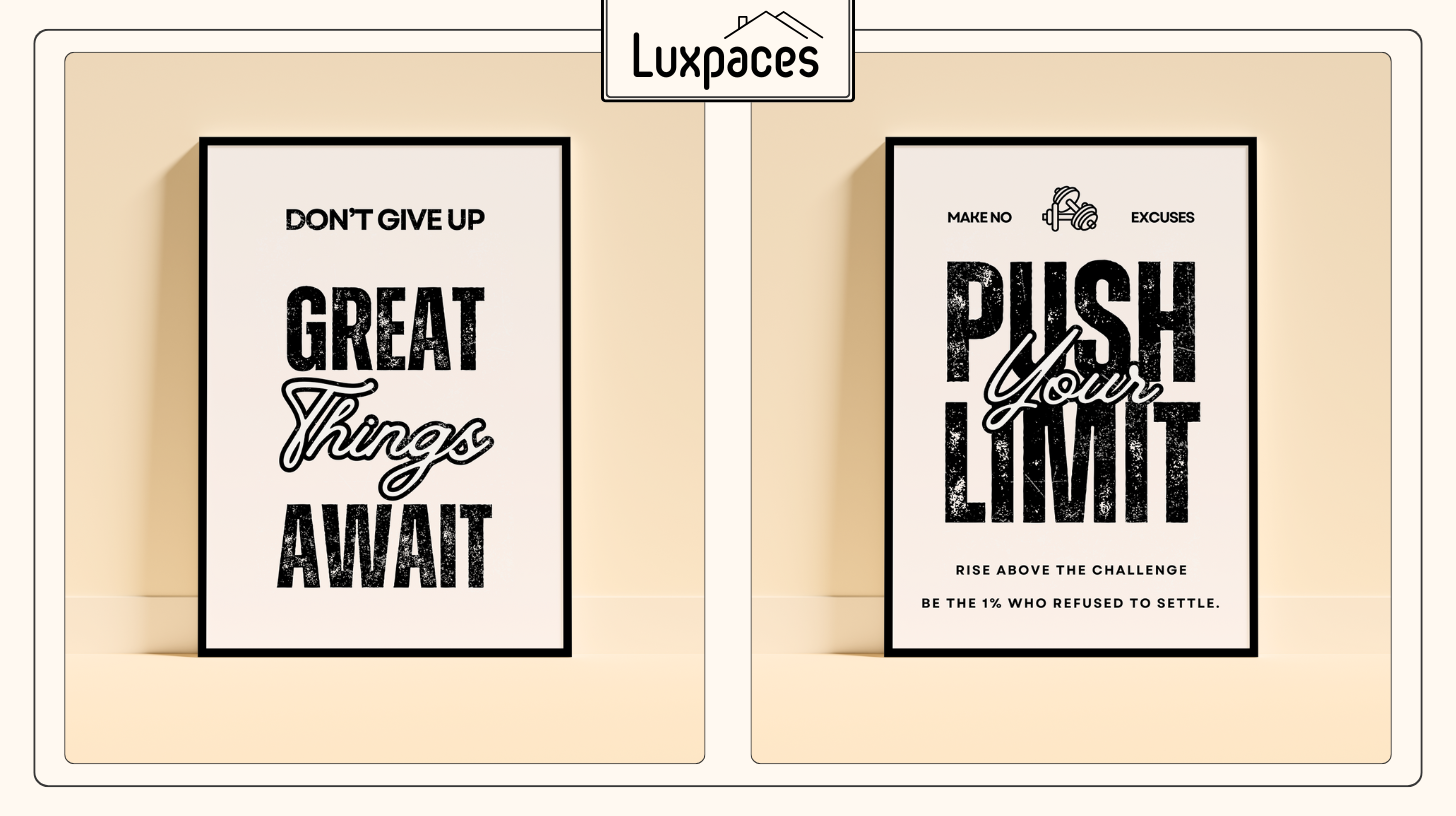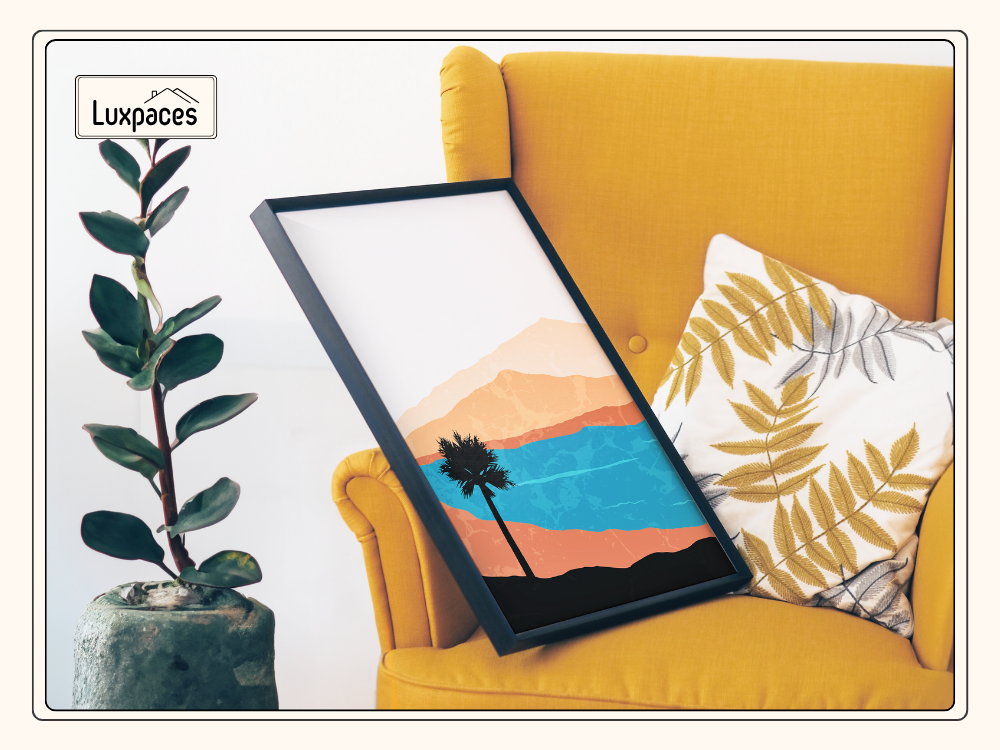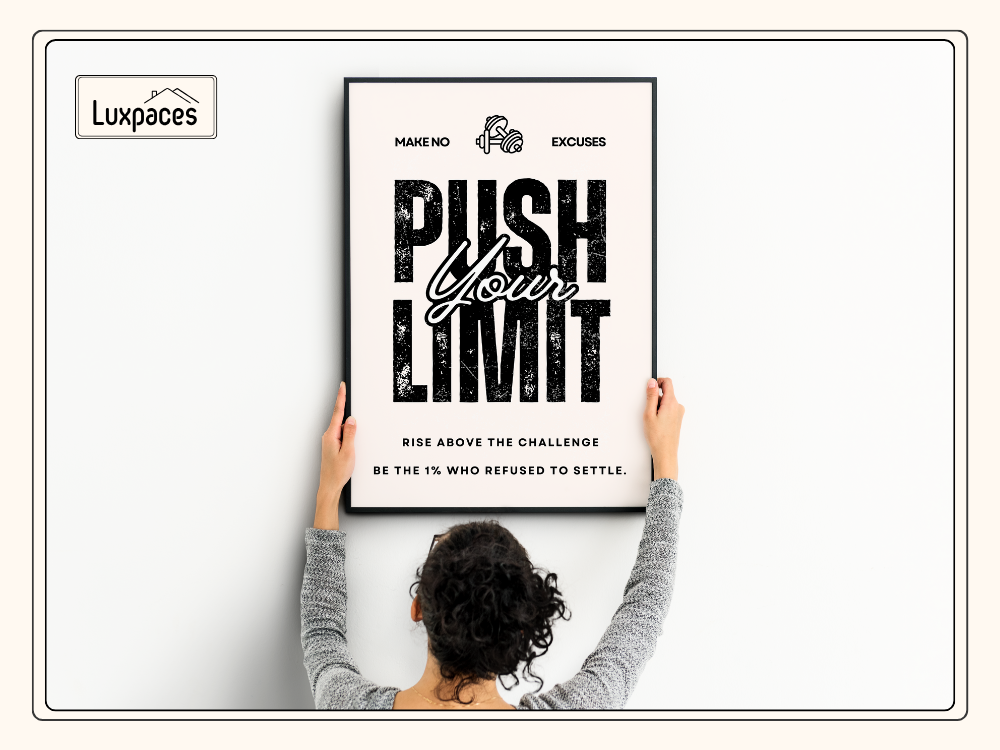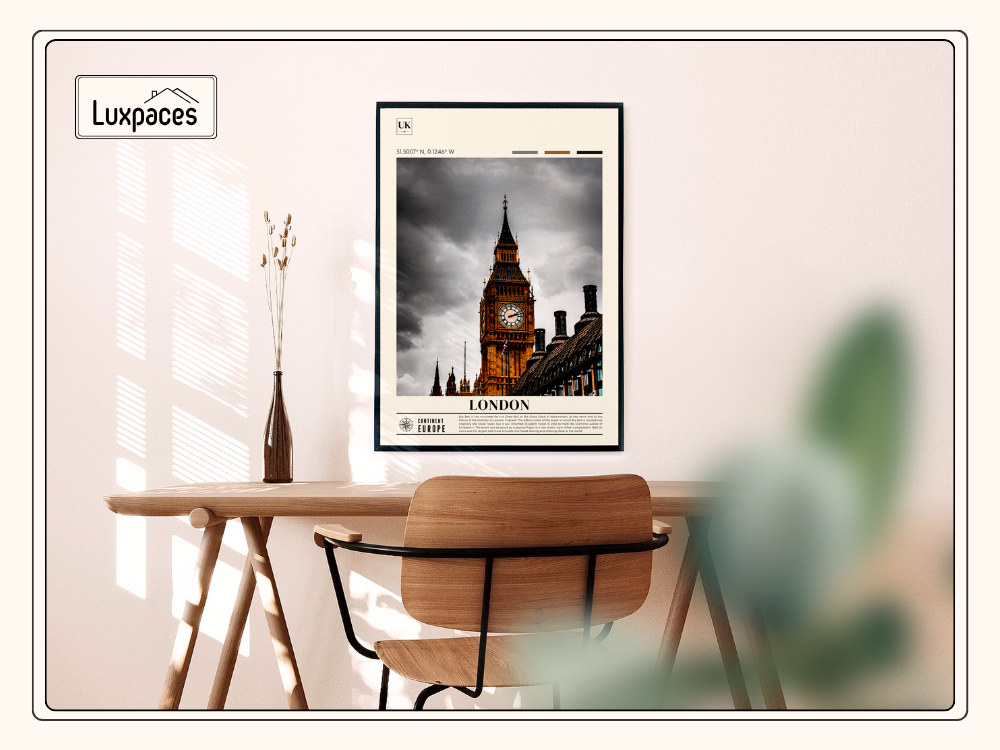
Why Wall Art Size Matters
Wall art serves a purpose far beyond simply filling empty walls in your home. It plays a crucial role in defining the overall style of a room, setting the desired mood, and bringing out the unique personality of your space. However, even the most stunning and thoughtfully chosen piece of artwork can seem out of place or awkward if its size doesn’t suit the wall or the furniture around it. For example, a canvas that’s too small above a large sofa can feel lost and insignificant, while an oversized print in a narrow hallway can overwhelm the space and create visual clutter. In both cases, the balance and harmony of the room are compromised.
This comprehensive wall art size guide will walk you through the essential principles of wall art sizing, offering practical advice on how to pick the right sizes for every room in your home. You’ll also find expert tips that will help you create a look worthy of an art gallery—one that perfectly complements your space and reflects your personal style.
Table of Contents
General Rules of Wall Art Sizing
Proportion Guidelines
When it comes to hanging art above furniture such as sofas, beds, or console tables, a good rule of thumb is to choose pieces that occupy roughly 60 to 75 percent of the available wall space. This proportion ensures that the artwork feels connected to the furniture rather than disconnected or too small. For walls without any furniture beneath them, aim for art that fills about 50 to 75 percent of the wall’s width or height. This balance helps maintain a visually pleasing and well-proportioned look, preventing the artwork from either dominating the space or looking too sparse.
Ideal Placement
The placement of your wall art can be just as important as its size. The general recommendation is to hang art so that the center of the piece sits at eye level, which is typically around 57 to 60 inches from the floor. This height makes the art naturally engaging and comfortable to view. When hanging art above furniture, it’s important to leave some breathing room; a spacing of about 6 to 12 inches between the top of the furniture and the bottom edge of the artwork creates a harmonious connection without crowding.

Orientation Matters
The orientation of the artwork should complement the shape and size of the wall or furniture beneath it:
- Landscape (horizontal) orientation tends to work best over wide surfaces like sofas, beds, or long consoles. It mirrors the horizontal lines in the furniture and balances wider spaces elegantly.
- Portrait (vertical) orientation is ideal for narrow or tall spaces such as hallways, entryways, or spaces between windows. Vertical pieces draw the eye upward and help emphasize height, making these tighter spaces feel more dynamic and inviting.
Wall Art Sizes Explained
Understanding the common size categories for wall art can simplify your selection process. Here’s a breakdown of typical dimensions and their ideal uses:
Small (Under 18 inches)
Small art pieces are perfect for tight spaces or when creating a gallery wall with multiple pieces. These include mini frames, postcards, or petite canvases. Because of their size, they can be paired together to form visually interesting groupings or used to add subtle touches of color and texture in spaces like bathrooms, kitchens, or narrow corridors.
Medium (18 to 36 inches)
Medium-sized artwork is the most versatile and popular choice for many spaces. These pieces can stand alone as a focal point above smaller furniture or be combined with others for a balanced and cohesive look. Medium art is suitable for most rooms and is often the go-to size for home offices, dining rooms, or bedrooms.
Large (36 to 48 inches)
Large art pieces make a bold and confident statement, working beautifully above larger furniture such as beds, sofas, or dining tables. These pieces draw attention and anchor a room, providing a sense of scale and importance to the wall they occupy. Large artworks are ideal when you want to create a striking centerpiece that defines the style of the room.
Oversized (Over 48 inches)
Oversized artwork is best suited for minimalist interiors or large, open walls where the piece can serve as the focal point of the space. These substantial pieces command attention and can be displayed in a variety of ways, including leaning casually against a wall for a modern, relaxed vibe. Oversized works are often seen in spacious living rooms, lofts, or galleries, where their scale feels appropriate.

Room-by-Room Wall Art Sizing Guide
Living Room
- Above the Sofa: When selecting art to hang above a sofa, aim for a piece that measures about two-thirds to three-quarters the width of your sofa. For instance, if your sofa is 84 inches wide, then artwork measuring approximately 56 to 63 inches wide will look perfectly proportioned and balanced. This helps the artwork and sofa feel connected as a unified visual element.
- Gallery Wall Option: Instead of a single large piece, you might consider creating a gallery wall made up of several medium or small-sized pieces arranged thoughtfully across the same width. This approach allows for a personalized and eclectic display that can highlight different styles or themes.
- Don’t Overcrowd: It’s important to leave enough space around your art and between individual pieces if you are creating a gallery wall. Adequate breathing room keeps the display from feeling cluttered or overwhelming.
Bedroom
- Above the Bed: Art above a bed should be carefully sized to complement the headboard and overall scale of the room. Choose artwork that is about 60 to 80 percent the width of your headboard for a balanced look. You can use one large piece centered above the bed or a grouping of two or three smaller pieces to fill the space effectively.
- Pro tip: Soft, muted colors or calming themes in your bedroom artwork can enhance the room’s restful atmosphere, helping create a tranquil retreat.
Dining Room
- Over a Buffet or Sideboard: Medium or large artwork pieces centered above buffets or sideboards work wonderfully to ground the furniture and add visual interest to the dining area.
- Be mindful of the space around lighting fixtures such as chandeliers. Leave some gap between the top of your artwork and the fixture to avoid a cramped or busy feel.
- Consider using symmetrical pairs of artwork or horizontal orientations to echo the clean, linear lines commonly found in dining room furniture and fixtures.
Kitchen
- Kitchens generally call for smaller art pieces, such as 8×10 or 12×12 inch prints. These sizes fit nicely above cabinets, countertops, or in breakfast nooks without overwhelming the space.
- Choose playful, themed, or food-related artwork that complements the kitchen’s atmosphere while keeping the walls from feeling cluttered.
Entryway or Hallway
- Entryways and hallways often have limited wall space, so narrow, vertical artwork or small gallery walls work best here.
- In long hallways, a series of equally sized pieces placed in a row creates a rhythmic flow and keeps the eye moving, making the corridor feel more dynamic.
- Keep spacing between pieces tight—usually 2 to 3 inches apart—so that smaller artworks appear as part of a cohesive unit rather than scattered objects.
Bathroom
- Bathrooms require moisture-resistant art, so opt for small to medium-sized pieces framed under glass or acrylic to protect them.
- Place artwork strategically above towel racks, opposite mirrors, or beside vanities to add charm without crowding the space.
- Choose light, airy themes such as nature prints or minimalist abstract designs that enhance the relaxing atmosphere typical of bathrooms.
Home Office
- Artwork in a home office should inspire focus or promote calm without dominating the workspace.
- Medium-sized pieces work well above desks, or you can try a balanced grid layout to bring order and interest to the wall.
- Another option is to position one large print directly behind your office chair or create a symmetrical set above your computer monitor for a polished, professional look.

Layout Tips and Visualization Tools
- Painter’s Tape: Before hanging any artwork, use painter’s tape to outline the frame sizes directly on your walls. This simple trick helps you preview the composition and spacing without making holes or committing to nails.
- Paper Templates: Cut out craft paper or newspaper sheets to the exact size of your intended artwork and tape them to the wall. This allows you to experiment with different arrangements and placements visually.
- Use a Level: A level is essential to ensure your frames hang straight, especially when creating multi-piece gallery walls. Clean alignment keeps the display polished and professional.
- Spacing Rules: When arranging multiple pieces, maintain consistent spacing of about 2 to 3 inches between frames. Avoid overcrowding, as uneven or excessive spacing can disrupt the flow and harmony of your wall.
Common Mistakes to Avoid
- Art that’s Too Small: One of the most frequent mistakes is choosing artwork that is too small for the space it occupies. Smaller pieces can easily get lost on large walls or above large furniture. It’s generally better to scale up your art than down.
- Placing Art Too High: Hanging artwork too high above furniture makes it feel disconnected and awkward. Stick to eye-level placement to keep the art approachable and visually connected.
- Ignoring Furniture Width: Artwork narrower than the furniture beneath it can create an unbalanced look, making the space feel fragmented rather than unified.
- Poor Gallery Wall Spacing: Uneven or overly wide spacing between gallery pieces disrupts the visual flow. Keep spacing tight and consistent for a cohesive presentation.
If you’d like a more detailed breakdown on how to avoid common wall art sizing and placement mistakes, be sure to check out our in-depth article: Article Here
Final Tips for Sizing Success
- Always measure your wall and furniture carefully before selecting artwork. Knowing exact dimensions helps you avoid costly mistakes and ensures a perfect fit.
- Consider the visual weight of the piece—not just its physical size. Dark, bold, or highly detailed artwork can feel heavier and require more space than a light, simple print.
- Use cohesive frames or color palettes when combining multiple pieces to tie them together visually and create a harmonious display.
- If you’re uncertain about where to start, begin with one main statement piece and build your arrangement around it. This approach provides a clear focal point and simplifies the design process.
Conclusion
Choosing the right size for your wall art can dramatically transform any room by adding harmony, depth, and personality. With the guidance provided in this wall art sizing guide, you now have the tools and knowledge to select pieces that not only match your style but also fit your space beautifully. Whether you’re creating a bold, dynamic gallery wall in your living room or adding subtle charm to a quiet hallway, remember this key takeaway: size matters just as much as style when it comes to wall art.
Visit Our Store
Visit our store now to explore wall art in sizes that fit every space. Our curated collection includes pieces for every room size, style, and layout. You’ll find bold statement canvases and versatile gallery sets that make it easy to apply what you’ve learned about choosing the perfect wall art size. Decorating becomes simple, with no guesswork needed.
No matter the size of your space—whether it’s a cozy apartment or a spacious home—our selection is organized by room type, wall size, and layout tips to help you visualize how each piece will look. Your walls deserve more than a blank stare.
